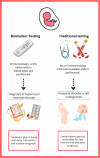Application of Proteomics in Maternal and Neonatal Health: Advancements and Future Directions
- PMID: 40128623
- PMCID: PMC12069003
- DOI: 10.1002/prca.70004
Application of Proteomics in Maternal and Neonatal Health: Advancements and Future Directions
Abstract
Maternal and neonatal health (women during pregnancy, childbirth, and the postnatal period) presents a spectrum of healthcare challenges, including preterm birth, preeclampsia, intrauterine growth restriction, polycystic ovarian syndrome, and gestational diabetes mellitus. While genomic investigations have shed light on many of these topics, protein biomarker discovery, a pivotal aspect of such research, holds promise in offering insights into disease diagnosis, progression, and prognosis. This review paper aims to explore the landscape of proteomics research pertaining to the aforementioned disorders. In the search for viable biomarkers, existing ones are either outdated or lack specificity and new ones being investigated do not commonly make it to the validation stage. In this review, the reasons for the gap between the biomarker discovery stage and the clinical validation stage are evaluated, in addition to what steps are being taken to mitigate the unexpectedly slow scientific and clinical progress. Notably, this paper also delves into the ethnic disparities found in maternal and neonatal health research, as well as how AI is currently being used to alleviate socioeconomic and ethnic disparities, as well as its advantages for the analysis of large "omics" datasets. We anticipate this investigation will provide critical, invaluable information for researchers, medical professionals, and policy decision-makers in this field to improve overall maternal and neonatal health outcomes.
Keywords: AI; biomarker discovery; biomarkers; clinical validation; ethnic populations; maternal health; neonatal health; preterm birth; proteomics; racial disparity.
© 2025 The Author(s). PROTEOMICS ‐ Clinical Applications published by Wiley‐VCH GmbH.
Conflict of interest statement
The authors declare no conflicts of interest.
Figures




Similar articles
-
The future of Cochrane Neonatal.Early Hum Dev. 2020 Nov;150:105191. doi: 10.1016/j.earlhumdev.2020.105191. Epub 2020 Sep 12. Early Hum Dev. 2020. PMID: 33036834
-
Precision medicine activities and opportunities for shaping maternal and neonatal health in Qatar.Per Med. 2024;21(5):313-333. doi: 10.1080/17410541.2024.2394397. Epub 2024 Sep 30. Per Med. 2024. PMID: 39347749 Review.
-
Clinical and economic evaluation of a proteomic biomarker preterm birth risk predictor: cost-effectiveness modeling of prenatal interventions applied to predicted higher-risk pregnancies within a large and diverse cohort.J Med Econ. 2022 Jan-Dec;25(1):1255-1266. doi: 10.1080/13696998.2022.2147771. J Med Econ. 2022. PMID: 36377363
-
Maternal Metabolic Health and Mother and Baby Health Outcomes (MAMBO): Protocol of a Prospective Observational Study.JMIR Res Protoc. 2025 Apr 11;14:e72542. doi: 10.2196/72542. JMIR Res Protoc. 2025. PMID: 40215105 Free PMC article.
-
Antenatal Care Strategies to Improve Perinatal and Newborn Outcomes.Neonatology. 2025;122(Suppl 1):13-31. doi: 10.1159/000542702. Epub 2024 Nov 23. Neonatology. 2025. PMID: 39581186 Free PMC article. Review.
Cited by
-
Machine learning for the prediction of spontaneous preterm birth using early second and third trimester maternal blood gene expression: A cautionary tale.PLoS One. 2025 Jun 27;20(6):e0310937. doi: 10.1371/journal.pone.0310937. eCollection 2025. PLoS One. 2025. PMID: 40577367 Free PMC article.
References
-
- “Trends in Maternal Mortality 2000 to 2017: Estimates by WHO, UNICEF, UNFPA, World Bank Group and the United Nations Population Division,” World Health Organization . accessed February 26, 2024, https://iris.who.int/handle/10665/327595.
-
- “Maternal and Newborn Health,” UNICEF . accessed June 2, 2024, https://www.unicef.org/health/maternal‐and‐newborn‐health.
-
- Al‐Dewik N. I., Younes S. N., Essa M. M., Pathak S., and Qoronfleh M. W., “Making Biomarkers Relevant to Healthcare Innovation and Precision Medicine,” Processes 10, no. 6 (2022): 1107, 10.3390/pr10061107. - DOI
Publication types
MeSH terms
Substances
LinkOut - more resources
Full Text Sources
Miscellaneous

